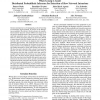80 search results - page 3 / 16 » The Analysis of Random Propagating Worms using Network Bandw... |
WORM
2003
13 years 8 months ago
2003
Due to the fast spreading nature and great damage of Internet worms, it is necessary to implement automatic mitigation, such as dynamic quarantine, on computer networks. Enlighten...
AAAI
2006
13 years 8 months ago
2006
Intrusion attempts due to self-propagating code are becoming an increasingly urgent problem, in part due to the homogeneous makeup of the internet. Recent advances in anomalybased...
CN
2007
13 years 7 months ago
2007
Worms are self-replicating malicious programs that represent a major security threat for the Internet, as they can infect and damage a large number of vulnerable hosts at timescal...
INFOCOM
2009
IEEE
14 years 2 months ago
2009
IEEE
Abstract—Recently, cellular phone networks have begun allowing third-party applications to run over certain open-API phone operating systems such as Windows Mobile, Iphone and Go...
INFOCOM
2003
IEEE
14 years 19 days ago
2003
IEEE
— It has been clear since 1988 that self-propagating code can quickly spread across a network by exploiting homogeneous security vulnerabilities. However, the last few years have...

